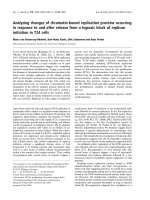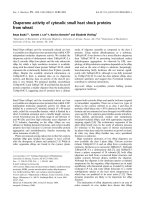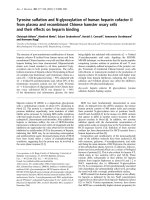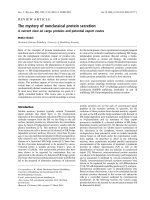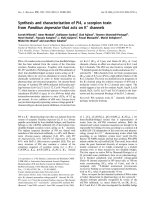Identification of Publications on Disordered Proteins from PubMed
Bạn đang xem bản rút gọn của tài liệu. Xem và tải ngay bản đầy đủ của tài liệu tại đây (1.83 MB, 61 trang )
Graduate School ETD Form 9
(Revised 12/07)
PURDUE UNIVERSITY
GRADUATE SCHOOL
Thesis/Dissertation Acceptance
This is to certify that the thesis/dissertation prepared
By
Entitled
For the degree of
Is approved by the final examining committee:
Chair
To the best of my knowledge and as understood by the student in the Research Integrity and
Copyright Disclaimer (Graduate School Form 20), this thesis/dissertation adheres to the provisions of
Purdue University’s “Policy on Integrity in Research” and the use of copyrighted material.
Approved by Major Professor(s): ____________________________________
____________________________________
Approved by:
Head of the Graduate Program Date
Sirisha Peyyeti
Identification of Publications on Disordered Proteins from PubMed
Master of Science
Dr. Yuni Xia
Dr. Keith Dunker
Dr. Jake Chen
Dr. Yuni Xia
Dr. Shiaofen Fang
07/14/2011
Graduate School Form 20
(Revised 9/10)
PURDUE UNIVERSITY
GRADUATE SCHOOL
Research Integrity and Copyright Disclaimer
Title of Thesis/Dissertation:
For the degree of
Choose your degree
I certify that in the preparation of this thesis, I have observed the provisions of Purdue University
Executive Memorandum No. C-22, September 6, 1991, Policy on Integrity in Research.*
Further, I certify that this work is free of plagiarism and all materials appearing in this
thesis/dissertation have been properly quoted and attributed.
I certify that all copyrighted material incorporated into this thesis/dissertation is in compliance with the
United States’ copyright law and that I have received written permission from the copyright owners for
my use of their work, which is beyond the scope of the law. I agree to indemnify and save harmless
Purdue University from any and all claims that may be asserted or that may arise from any copyright
violation.
______________________________________
Printed Name and Signature of Candidate
______________________________________
Date (month/day/year)
*Located at
/>Identification of Publications on Disordered Proteins from PubMed
Master of Science
Sirisha Peyyeti
07/14/2011
IDENTIFICATION OF PUBLICATIONS ON DISORDERED PROTEINS FROM
PUBMED
A Thesis
Submitted to the Faculty
of
Purdue University
by
Sirisha Peyyeti
In Partial Fulfillment of the
Requirements for the Degree
of
Master of Science
August 2011
Purdue University
Indianapolis, Indiana
ii
Dedicated to My Husband, In Laws,
Parents
and
Sister.
iii
ACKNOWLEDGEMENTS
I would like to convey my sincere thanks and
gratitude
to my committee chair and
advisor,
Dr. Yuni Xia, for her patience, continuous guidance and technical support
through the
course of my research work. I specially thank Dr. Keith Dunker and Dr.
Jake Chen for their
time,
in
terest
and support in introducing me to the world of bio-
informatics and disordered proteins
.
In addition, I would like to thank Dr. Robert W. Williams and Ms. Caron Morales.
They
b
oth
provided much
encouragemen
t
and were great mentors and often provided
much needed support and
ideas.
I would also like to thank NSF for supporting my research and the architects o f
NLProt for sharing their protein search tool. Finally, I would like to thank the entire
faculty and staff
at
Computer
Science
departmen
t
and at the Center for
Computational Biology and Bioinformatics for being helpful at all
times.
iv
TABLE OF CONTENTS
Page
LIST OF FIGURES vi
ABSTRACT viii
CHAPTER 1 INTRODUCTION 1
1.1 Introduction 1
1.2 Significance 4
1.3 Assumptions 5
CHAPTER 2 PROBLEM DISCUSSION AND LITERATURE REVIEW 6
2.1 Problem Discussion 6
2.2 Identifying Protein Names 7
2.2.1. Rule Based Systems 7
2.2.2. Machine Learning Systems 7
2.2.3 Dictionary Based Systems 8
2.3 Available Software Tools for Identifying Protein Names 9
2.3.1 Banner 9
2.3.2 ABNER 9
2.3.3 LingPipe 12
2.3.4 NLPROT 12
2.3.5 A Comparison of Existing Techniques to Identify Protein Names 12
2.4 Disorder Predictors 13
v
Page
CHAPTER 3 SYSTEM AND METHODS 15
3.1 Identifying Publications 15
3.2 Datasets 17
3.3 Tests and Results 18
CHAPTER 4 DISCUSSION 28
CHAPTER 5 USING DISPROT 29
5.1 Work Flow Diagram 29
5.2 Step by Step Description 30
LIST OF REFERENCES 37
APPENDIX 42
vi
LIST OF FIGURES
Figure Page
Figure 1.1 Number of publications retrieved from PubMed using keyword search 3
Figure 2.1 Sample Result from Banner 10
Figure 2.2 Sample Result from ABNER 11
Figure 2.3 Sample Result from NLProt 14
Figure 3.1 A graph showing number of structured proteins having 25 consecutive
disordered amino acids 20
Figure 3.2 Overall disorder percentages in the 100 structured proteins 21
Figure 3.3 A graph showing the total length of the protein 22
Figure 3.4 Score distribution for the test on 100 DisProt abstracts 23
Figure 3.5 Number of publications ranked as relevant 24
Figure 3.6 Number of true and false positives in identifying relevant abstracts 25
Figure 3.7 Number of true and false positives in identifying relevant abstracts 26
Figure 3.8 A comparative analysis of sensitivity, specificity and accuracy 27
Figure 5.1 Workflow for the algorithm 29
Figure 5.2 A screen shot of abstracts upload mechanism 32
Figure 5.3 A screen shot of pre-processed abstracts 33
Figure 5.4 A screen shot of NLProt output 34
Figure 5.5 A screen shot of a abstract in the output 35
Figure 5.6 A screen shot of final output 36
vii
LIST OF ABBREVIATIONS
IDP Intrinsically Disordered Protein
IDPs
Intrinsically Disordered Proteins
IDR
Intrinsically
Disordered Region
IDRs
Intrinsically
Disordered Regions
viii
ABSTRACT
Sirisha, Peyyeti. M.S., Purdue University, August 2011. Identification of Publications on
Disordered Proteins from PubMed. Major Professor: Yuni Xia.
The literature corresponding to disordered proteins has been on a rise. As the
number of publications increase, the time and effort needed to manually identify the
relev
an
t
publications
and protein information to add to centralized repository (called
DisProt) is becoming arduous
and
critical. Existing search facilities on PubMed can
retrieve a seemingly large number of
publications
based on keywords and does not
have any support for ranking them based on the probability of
the
protein names
mentioned in a given
abstract
being added to DisProt. This thesis explores a novel
system of using disorder predictors and context based dictionary methods to quickly
iden
tify
publications on disordered proteins from the PubMed database
.
NLProt, which is built around Support Vector Machines, is used to identify protein
names
and
PONDR-FIT
which is an Artificial Neural Network based meta-
predictor is used for
identifying
protein
disorder. The work done in this thesis is of
immediate significance in identifying
di
s
o
rdered
protein names
.
We have tested the new system on 100
abstracts
from DisProt [these
abstracts
w
ere
found to be relev
an
t
to disordered proteins and were added to DisProt manually by
the annotators.]
This system
had an accuracy of 87% on this test
set. We then took
another 100 recently added
abstracts
from PubMed and ran our algorithm on them.
This time
it
had an accuracy of 68%.
W
e
suggested improvements to increase the
accuracy and believe that this system can
b
e
applied for identifying disordered proteins
from
literature.
1
CHAPTER 1 INTRODUCTION
1.1 Introduction
The Experiments and predictors developed by numerous researchers have shown that
many
proteins
lack rigid 3D
structure
under physiological conditions in vitro,
existing instead as
dynamic
ensembles of
in
t
er conv
erting
structures
that we are
calling intrinsically disordered (ID) proteins [1, 2]. Indeed, the
literature
published on
these ID proteins is virtually ex p lo d i n g (see Figure 1.1).
This
literature
explosion is
con
sisten
t
with bio-informatics studies indicating that about 25 to 30% of eukaryotic
proteins are mostly disordered [3], that more than half of eukaryotic proteins have long
regions of disorder [3, 4], and that more than 70% of signaling proteins have long
disordered regions [5]
.
DisProt is a database that is aimed at becoming a central repository of disorder
related
information [6, 7]
and it makes a best effort in providing
structure
and function
information
ab
out
proteins that lack a fixed
3D structure
under putatively native
conditions, either in their
en
tireties
or in part. There are currently 643 disordered
proteins and 1375 disordered regions in DisProt.
The
number of publications shown
in Figure 1.1 indicates that there are even more disordered
proteins
t
han
the numbers
indicated in DisProt. Owing to the exponential rise in publications, it is a difficult, time
consuming and resource intensive manual task to be abreast w i th
the
publica
tions
and to read them to identify the most relev
an
t
abstracts.
Having an
automated
method to
estimate
relevance of a PubMed publication to be a new DisProt entry and
extract the protein
information
would significantly con
t
ribute
to increasing the
number of entries in DisProt and reduce
the
amoun
t
of manual work required by
annotators
to add new
proteins.
2
In this thesis we aimed to take the
curren
t
state of art of identifying disordered
protein
names
a
step forward by applying the concepts of search relevance
ranking,
protein name extraction and disorder predictors.
As an exploratory study, we selected three key features to estimate relevance:
a.
An expansive set of keywords that w ou l d describe the
structure
of a
disordered
protein.
b.
Listing of the detection methods that are used for identifying disordered
proteins.
c.
PONDR
-FIT disorder prediction score for the proteins mentioned in the
publication.
We
te
s
t
ed
this idea on a set of 100
abstracts
from DisProt and we could identify the
abstracts
related
to disordered proteins with 87% accuracy. We repeated the test on a
set of 100
abstracts
f
rom
PubMed
and had an accuracy of only 60% because of high
amoun
t
false positives by the feature c.
W
e
studied the results of the test and made an
observation that not all abstracts having a
disordered
protein
presen
t
in the
abstract,
discuss about the
structure
or experimental methods of
the
disordered
protein and one
of the criterion for adding publications to DisProt is that the
publication
should be
discussing about the
structure
of a disordered protein or an experimental result
p
erformed on a disordered
protein.
So, we modified the algorithm to
fir
s
t
identify papers that discuss about the structure
or
an
experimental method for a disordered protein and then to check if the selected
papers have a
protein
name. If they have a protein name, we try to determine the
chance of that protein
b
eing disordered based on its proximity from the protein search
terms, detection methods and
the
prediction results of PONDR. We tested this modified
algorithm on the 100
abstracts
from
PubMe
d
and had 70%
accuracy.
3
Figure 1.1 Number of publications retrieved from PubMed using keyword search.
4
1.2 Significance
One of the methods that investigators working on DisProt use to identify disordered
proteins
is literature search, specifically by searching the PubMed using the keywords.
[See Appendix A.1]
This is one of
the
methods that have worked well so far. Nearly 50000
abstracts
were
found on PubMed by querying PubMed for the search terms mentioned in Appendix
A.1 and manually
reading
each of these
abstracts
to identify disordered protein
names would be a difficult and time consuming task. 5.7 Release of DisProt has 643
disordered protein entries and 1375 disordered regions. So, there is a good probability
that this work would assist in identifying highly relev
an
t
abstracts and
reduce the
number of papers that will require reading by human experts. The work done in
this
thesis can be of immediate use to the annotators at
DisProt and can assist in
increasing the
en
tries
in DisProt, a widely used public database of protein disorder.
5
1.3 Assumptions
The following are the assumptions in the
study:
a.
Either the protein name or the search terms
men
t
ioned under significance
sections or
the
detection methods used for finding a disordered protein occurs
in the
abstract.
b.
The protein name that is closest to the disorder search term is the disordered
protein
that
the
author of the paper is referring
to.
c.
NLProt [8, 9] is used in this study to identify the protein names from
abstract.
We have found in our preliminary tests that it can identify protein names with
88.7% accuracy but while designing the disorder protein identification
algorithm we
assumed
NLProt
has accurately identified all the protein names
and have built our algorithm on top of
it.
d.
PONDR-FIT
[10] is used in this study to identify protein disorder. We tested
the results of
PONDR-FIT
on 100
structured
and 100
unstructured
proteins
and made the
assumption
that
at least 25 consecutive segments in the protein
sequence are predicted as disordered
or
segments comprising of at least 25% of
overall protein length are predicted as disordered
b
y
PONDR-FIT.
6
CHAPTER 2 PROBLEM DISCUSSION AND LITERATURE REVIEW
2.1 Problem Discussion
The problem that w e are addressing in this thesis is to identify the publications
returned from PubMed search based on their relevance to a disordered protein. We
proposed to solve this
problem
by assigning a higher score to a publication that has
mention about disordered proteins. So,
our
problem is to identify disordered proteins
from publications. We subdivided this problem into two
problems:
a.
Problem 1 Identifying protein names from
publications.
b.
Problem 2 Predicting if a protein is
disordered.
Considerable
amoun
t
of work has been done and number of approaches has been
proposed on both the problems. A brief
literature
review is presented in
Section 2.2.
7
2.2 Identifying Protein Names
A number of methods have been proposed for identifying protein names from
scientific
abstracts.
They differ in their degree of reliance on dictionaries, Statistical
or Knowledge
B
ased approaches
, and in the rule generation mechanism (manual vs.
automatic).
All methods can
b
e
roughly split into three categories:
Dictionary Based
approaches, Rule Based approaches, and Machine Learning approaches, and although
some
in
teresting
mixed systems have also been
described.
2.2.1. Rule Based Systems
Rule Based Systems rely on a set of expert derived rules, which may combine
w
ord
alphanumerical composition, presence of special symbols, and capitalization
with
word
s
y
n
tactic
and
semantic properties, to initiate, ex t en d , and terminate
the chains
of sentence tokens. Some systems can also use small dictionaries to improve precision
and recall. Examples of
Rule Based
Systems are presented in:
a.
Narayanaswamy et al. [11] (precision 96%, recall 62%)
b.
Fukuda et al. [12] (precision 40%, recall 40%)
c.
And Franzen et al. [13] (precision 68%, recall
%).
d.
Seki and Mostafa [14] used surface clues to anchor a protein name, but instead
of
syn
tactic
features they used word first order transition
probabilities learned
from annotated test corpora used in the original ma t ch . The reported precision
and recall rates are 60% and 66%,
resp
ec
tiv
ely
.
2.2.2. Machine Learning Systems
Machine Learning approaches rely on the presence of an
expert annotated
training
corpus
to
automatically
derive the identification rules by means of various
statistical
algorithms.
The features used in Machine Learning methods are mostly the same as
those
in
Rule Based approaches: surface clues, parts of speech, and, sometimes,
semantic word
properties
obtained from rough classification. Nobata et al. [15] used
Bayesian classifier and decision
tree
algorithms to identify a noun phrase as a protein,
based on its word composition. They report an F-score of 70% to 80% for protein
detection. Collier et al. [16] used a first order hidden
Mark
o
v model (HMM) trained
on
annotated
corpus to
detec
t
the protein names in text and report a 76% F-score.
8
Kazama et al.
[17]
applied support vector machines to the same problem and achieved
a 65% F-score. Burr Settles et al.
[21]
applied linear chain 1st order conditional random
fields and
ac
hiev
ed
72.46 F-score. Robert Leaman et al. [22] applied second order
conditional random fields
and
achieved 81.96%
F-score.
2.2.3 Dictionary Based Systems
Dictionary Based approaches utilize a provided list of protein terms to identify
protein
occurrences in a text, usually by means of various substring matching techniques. Proux
e t al
.
[19] used a Drosophila protein dictionary derived from a fly base for identification
of proteins with 91% precision and 94% recall. However, they recognized only single
word protein names. They also reported that precision of the system dropped from
91% to 70% when transferred from
a
corpus of sentences from fly base to a more
general set of Medline articles. An
in
teresting
combination of the
Dictionary Based
approach with the Basic Local Alignment Search Tool (BLAST)
based identification
algorithm has been proposed
b
y
Krauthammer
et al. [20]. The basic idea was to
perform an approximate string match
after
converting both input text and a dictionary
into the DNA sequence like strings. The
authors
rep
orted
79% recall and 72%
precision.
2.2.4 A Hybrid System
An interesting combination of a Machine Learning approach with
hand crafted
rules
is
rep
orted
in Tanabe and Wilbur [18]. As a first step, the
transformation-
based
part of
speech tagger
has been trained on the corpus of Medline sentences with hand marked
gene occurrences
to
induce the rules for tagging the text. Next, a
complex set of
manually derived
contextual,
morphologic, and
Dictionary Based
post processing
rules
have been applied. Reported precision and recall are 86% and 67%, respectively.
Sven Mika
,
Burkhart Rost et al.
[8,
9] developed a system based on support vector
machines.
Additionally
filtering rules and protein name dictionary are used to
improve performance. Reported precision and recall are 70% and 85%
respectiv
ely.
9
2.3 Available Software Tools for Identifying Protein Names
Many Solutions have been implemented for protein name
iden
t
ification, among them
NLProt
[8,
9] produces good result by combining dictionary based method and support
vector
machines,
Banner [22], ABNER [21], GENIA [36]
also produce good results
based on Conditional
Random
Fields. Few of these solutions are described and
compared in the following subsections. These software tools are open sourced o r
licensed under GPL and are available freely for research and educational purposes
.
2.3.1 Banner
It is an open-sourced, executable survey of advances in biomedical named entity
recognition,
intended to serve as a benchmark for the field. It is implemented in Java
as a machine-learning system based on conditional random fields and includes a wide
survey of the best techniques recently described in the
literature.
It is designed to
maximize domain independence by not employing brittle semantic features or rule-
based processing steps. The details of the system are described in this paper. A sample
output
is shown in Figure 2.1.
2.3.2 ABNER
ABNER is a software
t
ool
for molecular biology text analysis. It began as a user-
friendly interface for a system developed as part of the
NLPBA / BioNLP
2004 Shared
Task challenge.
The
details of that system are described in (Settles, 2004) [21].
At
ABNER’s core is a
statistical
machine
learning system using linear-chain conditional
random fields (CRFs) with a variety of orthographic and contextual features. Version
1.5 includes two
models trained o n the NLPBA and Bio Creative corpora, for which
performance is roughly state of the art (F1 scores of 70.5 and 69.9 respectively). The
new version also includes a
Ja
v
a
API allowing users to incorporate ABNER into
their
systems, as well as train and use models for other data. A sample
output
is shown
in
Figure 2.2.
10
Figure 2.1 Sample Result from Banner.
11
Figure 2.2 Sample Result from ABNER.
12
2.3.3 LingPipe
Lingpipe is open source Natural Language Processing software that is developed by
Alias-I, incorporated ( LingPipe is regarded as “a suite of Java
tools designed
to
perform linguistic analysis on
natural
language data.”
LingPip
e
provides linguistic analysis functions such as sentence boundary detection and named
entity
detection
using first order hidden markov models.
2.3.4 NLPROT
NLProt is a novel system that combines Dictionary and Rule Based filtering with
sev
eral
supp
ort
vector machines (SVMs) to tag protein names in PubMed abstracts
.
When considering partially t a gg e d names as errors, NLProt still reached a precision
of 70% at a recall of 85%. By many criteria this system outperformed other tagging
metho
ds
significantly; in
particular,
it proved very reliable even for novel names.
Input can
b
e
PubMed or MEDLINE
identifiers, authors, titles and journals, as well
as collections of
abstracts or entire
papers. A sample
output
of
NLPro
t
is shown in
Figure 2.3.
2.3.5 A Comparison of Existing Techniques to Identify Protein Names
Compared with Rule Based approaches,
Dictionary Based
protein identification systems
are
more accurate, and their performance is in direct correlation with the quality and
completeness of the provided protein dictionaries. Developmen
t
and maintenance o f
comprehensiv
e
protein name dictionaries is not simple task because new proteins are
constantly being identified. However, both Machine Learning
and
Rule Based
approaches require
s
ig
nifican
t
amounts of expert work for creation of rules
and
manual
tagging of the training corpus respectively.
13
2.4 Disorder Predictors
One approach that has been important in the study if IDPs and IDRs is the use of
disorder predictors. This method is extremely powerful in terms of time and cost of
study of disordered proteins compared to traditional experimental methods [23–26].
More than 50 predictors have been developed by now [27]. These include the early
PONDR series [28–30], DisEMBL [31], DISOPRED [32], POODLE [33], DISPro
[34], IUPRED [35] and PONDR-FIT [10]. PONDR-FIT was assembled by
combining PONDR-VLXT, PONDR-VSL2 and PONDR-VL3 and the authors of
PONDR-FIT have reported an increase in accuracy in the aggregate as compared to
the individual component predictors.
Figure 2.3 Sample Result from NLProt.
14
15
CHAPTER 3 SYSTEM AND METHODS
3.1 Identifying Publications
Three differen
t
features are used to rank the publications returned from
PubMed
searc
h:
1.
feature 1 - keywords that would describe the
structure
or property of a
disordered
proteins
To benefit from the advantages of the frequently occurring words occurring in
the
context of describing disordered proteins, we compiled a list of keywords
.
These words
w
ere compiled under the guidance of an
annotator
who is
experienced in manually
reading
the
publications and identifying proteins. [Refer
to Appendix A.2 for a listing of the k
eyw
ords
used.]
2.
feature 2 - keywords that would describe the detection methods that are
commonly
used
for identifying disordered proteins
These words were compiled by using a combination of
the
detection methods
that are currently
presen
t
in DisProt database and from the listing of detection
methods by Uversky.
[Refer to Appendix A.3 for a listing of the keywords
used.]
3.
feature 3 - prediction result of a disorder predictor
Using disorder predictors has
b
een powerful in terms of time and cost to the
study of disordered proteins compared to
traditional
experimental methods
[23–26]. So, we are using
NLProt [8
,
9] to extract protein names and their
SwissProt ids, We use the SwissProt ID to get
the
protein sequence in fasta
format from UniProt and use this sequence as an input
to
PONDR-FIT
[10].
PONDR-FIT
returns a score for each amino acid in the sequence and we use
the following criterion to make the decision of whether the protein is disordered
or
structured.

